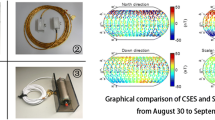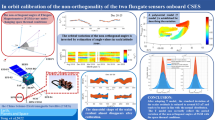Abstract
The China Seismo-Electromagnetic Satellite (CSES) is the first platform of China’s earthquake observation system in space and the first satellite of China’s geophysical field detection missions. The high precision magnetometer (HPM), which contains two fluxgate sensors and a coupled dark state magnetometer (CDSM), measures the vector of the Earth’s magnetic field with a bandwidth from DC to 15 Hz. The two fluxgate sensors are in a gradiometer configuration in order to reduce satellite interferences. Additionally, the CDSM sensor measures the scalar value of the magnetic field with higher accuracy and stability. Several data processing and calibration methods have been prepared to get accurate vector magnetic field data. This includes the calibration of each of the three sensors, the absolute vector correction algorithm, the spacecraft magnetic interference elimination and the coordinate transformation method. Also the instrument performances based on ground calibration activities are shown in this article.
Similar content being viewed by others
References
Shen X, Zhang X, Wang L, et al. The earthquake-related disturbances in ionosphere and project of the first China seismo-electromagnetic satellite. Earthq Sci, 2011, 24: 639–650
Thomas A P, Frederick F M, Lewis D E. The geomagnetic field and its measurement: Introduction and magnetic field satellite (MAGSAT) glossary. Johns Hopkins APL Tech Digest, 1980, 1: 161–170
Nielsen O V, Petersen J R, Primdahl F, et al. Development, construction and analysis of the “OErsted” fluxgate magnetometer. Meas Sci Technol, 1995, 6: 1099–1115
Olsen N, Tøffner-Clausen L, Sabaka T J, et al. Calibration of the Ørsted vector magnetometer. Earth Planet Space, 2003, 55: 11–18
Shen X H, Zhang X M, Yuan S G, et al. The state-of-the-art of the China seismo-electeomagnetic satellite mission. Sci China Tech Sci, 2018, 61: 634–642
Cao J B, Zeng L, Zhan F, et al. The electromagnetic wave experiment for CSES mission: search coil magnetometer. Sci China Tech Sci, 2018, 61: 653–658
Lin J, Shen X H, Wang L W. CSES GNSS ionospheric inversion technique, validation and error analysis. Sci China Tech Sci, 2018, 61: 669–677
Ambrosi G, Bartocci S, Basara L, et al. The HEPD particle detector of the CSES satellite mission for investigating seismo-associated perturbations of the Van Allen belts. Sci China Tech Sci, 2018, 61: 643–652
Wang L W, Shen X H, Zhang Y, et al. Developing progress of China seismo-electromagnetic satellite project. Acta Seismol Sin, 2016, 38: 376–385
Ding J H, Shen X H, Pan W Y, et al. Seiemo-electromagenetism precursor research progress. Chin J Radio Sci, 2006, 21: 791–800
Cheng B J, Zhou B, Magnes W, et al. Performance of the engineering model of the CSES high precision magnetometer. In: Proceeding of the IEEE Sensors, 2015. Busan, 2015. 1933–1936
Zhou B, Cheng B J, Zhang Y T, et al. Magnetic field detection method of China seismo-electromagnetic satellite. Chin J Space Sci, 2014, 34: 843–848
Lammegger R. Method and device for measuring magnetic fields. US Patent App. 12/664,782, 2008-06-12
Pollinger A, Ellmeier M, Magnes M, et al. Enable the inherent omnidirectionality of an absolute coupled dark state magnetometer for e.g. scientific space applications. In: Instrumentation & Measurement Technology Conference. Graz, 2012. 33–36
Pollinger A, Lammegger R, Magnes W, et al. Coupled dark state magnetometer for the China seismo-electromagnetic satellite. Measurement Sci Tech, 2018, in press
Zhang Z Q, Li L, Zhou B, et al. A method of in-orbit calibration of fluxgate magnetometer based on the measurement of absolute scalar magnetometer. Chin J Space Sci, 2014, 34: 235–241
Chen S W. Control and measure of satellite magnetic cleanliness. Progr Geophys, 2009, 24: 797–800
von Yin F. Mathematic approaches for the calibration of the CHAMP satellite magnetic field measurements. Dissertation for Doctoral Degree. Potsdam: Institutional Repository of the University of Potsdam, 2009. 11–17
Narvaez P. The magnetostatic cleanliness program for the cassini spacecraft. Space Sci Rev, 2004, 114: 385–394
Wang X F, Han X D, Yang C M. Method of earth’s magnetic field fluctuation compensated by Cs magnetometer. J Transducer Tech, 2004, 23: 47–49
Author information
Authors and Affiliations
Corresponding author
Rights and permissions
About this article
Cite this article
Cheng, B., Zhou, B., Magnes, W. et al. High precision magnetometer for geomagnetic exploration onboard of the China Seismo-Electromagnetic Satellite. Sci. China Technol. Sci. 61, 659–668 (2018). https://doi.org/10.1007/s11431-018-9247-6
Received:
Accepted:
Published:
Issue Date:
DOI: https://doi.org/10.1007/s11431-018-9247-6




